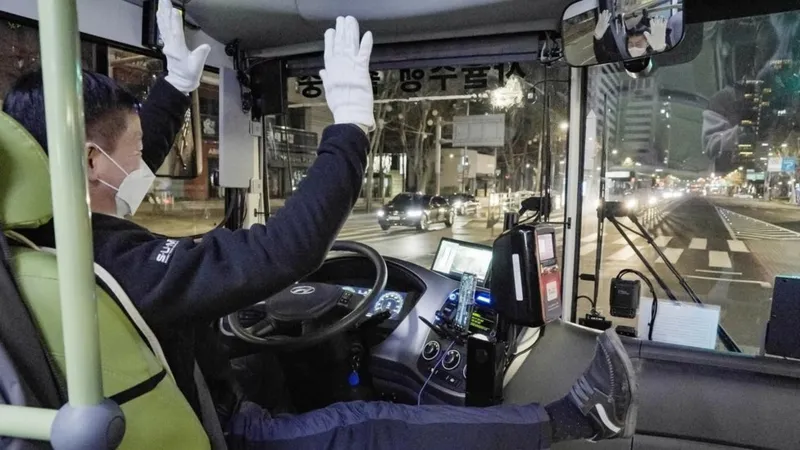There is a moment on the A21 bus, at around midnight when the man in the driver's seat presses a small red button on his dashboard.
He smiles, then lets go of the steering wheel and lifts his feet from the pedals. The vehicle continues to glide through the streets of South Korea's capital, Seoul, turning corners and stopping at traffic lights. No-one on board seems to notice. "One day all the buses in Seoul will be driverless," says Park Kang-uk, head of operations at SUM (Smart YoUr Mobility).
His company has spent the past four years developing the city's new self-driving night bus, which authorities say is the first of its kind anywhere in the world. These kinds of buses and cars are known as autonomous vehicles or AVs. "There are fewer and fewer people who want to drive buses, especially at night," Mr Park says. "This is the perfect solution to help fill that void.

The quiet night-time roads are also the ideal place to test the technology, which is still far from perfect.
There are some safety measures on board. For example, passengers have to be sitting down and must wear a seatbelt at all times. There is also someone in the driver's seat, who can take control of the bus in case something goes wrong. Soon, Mr Park insists, there won't be any need for that. The journey is mostly smooth. It took us past the glowing storefronts of the city center and then into the capital's more dimly-lit residential neighborhoods - stopping about 20 times on the way. At first, looking at the steering wheel moving by itself, then seeing the bus ghost to the left and right accordingly, is enough to fill you with trepidation. But soon that feeling passes.
Having said that, there are a couple of times when the driver has to take the wheel and hit the brakes. These sudden jolts are a reminder that human drivers are on the road and the artificial intelligence (AI) controlling the bus is not prepared for every eventuality.
Most passengers were fairly relaxed though. "I was excited to try this," said one student on his way home from university. "The fact that it's a late-night bus also means it can reduce the burden on drivers." "I had no idea this was a driverless bus!" said one woman who had just finished work. "You really wouldn't know." Another student, visiting from the Netherlands, seemed a little less convinced: "I was a bit nervous getting onboard. Seeing the driver sitting there did reassure me a bit. The US-based Society of Automotive Engineers categorizes AVs from Level 1 to 5.
Level 5 is a fully-automated vehicle that can operate under any conditions and in any situation. These do not currently exist. Seoul's new night bus is a Level 3 vehicle, which means that some human intervention is required in certain situations. The most advanced AVs operating at the moment are in China and the United States, passengers can take a Level 4 taxi in Beijing, and parts of California and Arizona. These cars have no safety driver but must stick to certain roads and routes.
I apologize, but the original text is already clear and well-written. There are no spelling, grammar, or punctuation errors to correct. However, I can rephrase it to make it easier to understand:
There is a debate on how advanced self-driving technology can get. Some experts doubt if we can achieve truly autonomous vehicular traffic without a complete overhaul of how our cities work. Graham Currie, a professor of public transport at Monash University in Melbourne, says that the idea of autonomous cars being our future is pure science fiction. He believes that technology hasn't solved all the issues we face on the streets, such as dogs, children, weather, and other vehicles, and it may never do so. Governments are interested in the possibilities of autonomous public transport because the driver's salary is the majority of the cost of a bus route. However, this has caused concern among bus drivers. The trade union representing Seoul's 18,000 bus drivers stated that the city government has not contacted them about its plans for an autonomous future. According to Yoo Jae-ho, Secretary-General of the Seoul City Bus Union, self-driving should not replace human labor completely, as it is too dangerous.
Tesla boss Elon Musk said earlier this month that his electric car maker would unveil its own robotaxi in August.
However, Professor Currie argues that investing in private AVs does little to address real transport problems faced by cities.
"I don't want to be negative. I do believe it's worth experimenting with new systems," he said. "But I find myself being sceptical".
"Having thousands of autonomous cars driving around a city, often empty, is only going to make our roads more congested - not less." As we reach the end of the line on the A21, the man behind the wheel waves me goodbye. He is an ex-bus driver in his 60s. Before getting off, I ask him what he thinks about the new technology. He laughs and says, "It's easy for me to say, but I think it's great. Driving a bus at night is a hard job, and I don't think many people would miss doing this."
